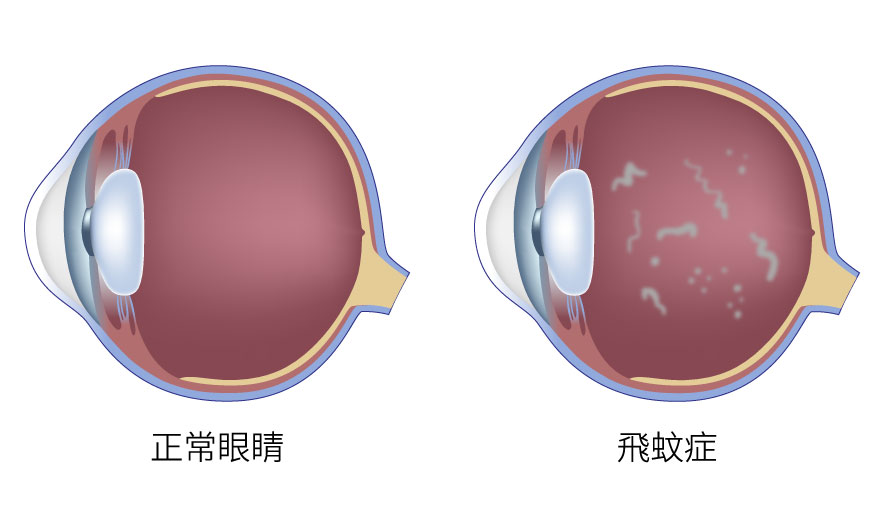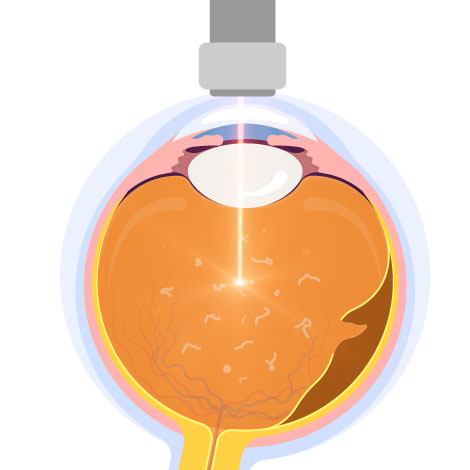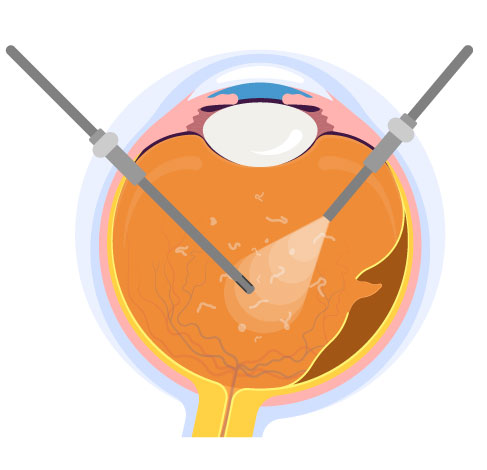


What are Eye Floaters?
Do you see any floaters in your field of vision, e.g. small black spots or blotches, threads, fragments of cobwebs? These are all symptoms of eye floaters.
Floaters occur when the normally clear vitreous inside the eye gradually degenerates, becoming liquefied and cloudy. Tiny debris then drifts within the vitreous. When light enters the eye, these cloudy tissues refract the light and cast shadows on the retina, which we perceive as floating spots. Causes include vitreous degeneration, posterior vitreous detachment, and retinal tears. However, if flashes of light or a sudden increase in floaters appear, this may indicate a possible retinal detachment. Immediate medical attention and an eye examination are required, so that an ophthalmologist can provide appropriate treatment to prevent permanent vision loss.
Causes of Eye Floaters

Vitreous degeneration due to aging
Aging of the eyes is the most common cause. As age increases, the vitreous body of the eye degenerates and shrinks, gradually detaching from the originally tightly bound retina, and the vitreous body fibers inside may become turbid, projecting many small black dots on the retina, becoming a common sight for people with floaters.

Vitreous detachment from the retinal surface
Retinal detachment can cause floaters. If floaters are caused by retinal problems, you must seek medical attention immediately, otherwise it may lead to blindness in severe cases.

Retinal holes
A tear in the retina can cause floaters. If floaters are caused by retinal problems, you must seek medical attention immediately, otherwise it may lead to blindness in severe cases.

Diabetes
Diabetic patients are prone to new and abnormal blood vessels on the retinal surface. The blood vessels are fragile and prone to rupture, making the vitreous hemorrhage and retinal damage prone to blurred vision, making them more susceptible to floaters.

Deep myopia
The deeper the degree of myopia, the longer and longer the eyeball will become, and the tissue in the eye will be stretched, thinned, and even ruptured, thereby increasing the risk of retinal rupture and detachment, causing floaters.

Eyeball hemorrhage
Eyeball hemorrhage, also known as hemorrhagic floaters, as the name suggests, is caused by retinal hemorrhage, causing dense black spots to appear in front of the eyes, forming floaters.

Eye inflammation
If your eyes have been traumatized or inflamed, impurities may enter the vitreous and cause "floaters" to be seen in your eyes.
Symptoms of Floaters
According to patients' descriptions, common symptoms of floaters include: black spots in front of the eyes, black mesh-like floating objects, flashes of light, and a veil in the field of vision. These symptoms are particularly noticeable in brightly lit areas or against a white background. If the symptoms of floaters increase significantly, you should see an ophthalmologist immediately for a detailed eye examination.

Dark spots

Floating cobwebs

Flashes in vision

Veil crossing vision
Management of Floaters
In most cases, if floaters do not interfere with daily life, no treatment is necessary and patients simply adapt to living with them. However, if the floaters are very large or numerous, appear suddenly, or are accompanied by flashes of light that affect vision, it is recommended to seek prompt consultation with an ophthalmologist for possible surgical or laser treatment. In addition, patients with floaters are advised to undergo a retinal examination every six to twelve months. If symptoms worsen during this period, an earlier follow‑up and comprehensive examination should be arranged.
Laser Treatment
Laser treatment for floaters is mainly used to target larger, more concentrated vitreous opacities, breaking them into smaller fragments to reduce or eliminate symptoms. The procedure is painless and carried out under local anesthesia. However, not all patients are suitable candidates. For example, if the floaters are too diffuse or located too close to the macula or lens, the treatment is not recommended, as it may lead to complications such as cataracts or macular damage.

Vitrectomy
The vitreous inside the eye is removed through a small incision and replaced with a solution to maintain the eye's shape. Vitrectomy does not necessarily completely remove floaters, and new floaters may form if the surgery itself causes bleeding or retinal tears.


It is crucial to have regular eye examinations so that your doctor can be aware of any changes and help detect eye floaters and other abnormalities.
Floaters FAQ
Why do "floaters" appear?
When the transparent vitreous body in the eye gradually deteriorates, the vitreous body will liquefy and become cloudy, forming small debris floating in the vitreous body. There may also be flashes of light or a sudden large number of floaters due to retinal detachment, so regular eye examinations are required to follow up on the condition of the eyes.
Do floaters disappear or heal on their own?
Eye floaters do not go away over time, but they do become less noticeable and settle at the bottom of your eye.
Do eye floaters affect my vision?
In general, they do not affect the visual acuity and you can get used to floaters. If you see flashes or a sudden appearance of many floaters, these symptoms may indicate retinal detachment, which can be serious enough to cause permanent visual loss.
Can "floaters" be removed surgically?
There are 2 surgical options:
Laser Treatment
Laser treatment is used for larger and more concentrated vitreous floaters, breaking them into smaller fragments to reduce or eliminate symptoms. However, not everyone is a suitable candidate. For example, if the floaters are more diffuse or located too close to the macula or lens, treatment is not advised, as it may increase the risk of complications such as cataracts or macular damage.
Vitrectomy
The vitreous humour is removed through a small incision and replaced with a solution to maintain the shape of the eye. Vitrectomy does not necessarily remove the floaters completely, and new floaters may form if the surgery itself causes bleeding or slash in the retina.
How to distinguish physiological and pathological floaters?
Physiological floaters:
- Normal physiological changes in the vitreous body
- The vitreous body has congenital impurities in it
Pathological floaters:
- Retinal tears, peeling, punctures, and degeneration
- Vitreous hemorrhage
- Macular degeneration
- Eye bleeding and inflammation caused by diseases such as diabetes, hypertension, and ocular stroke
Why are people with diabetes more likely to have floaters?
Diabetic patients

